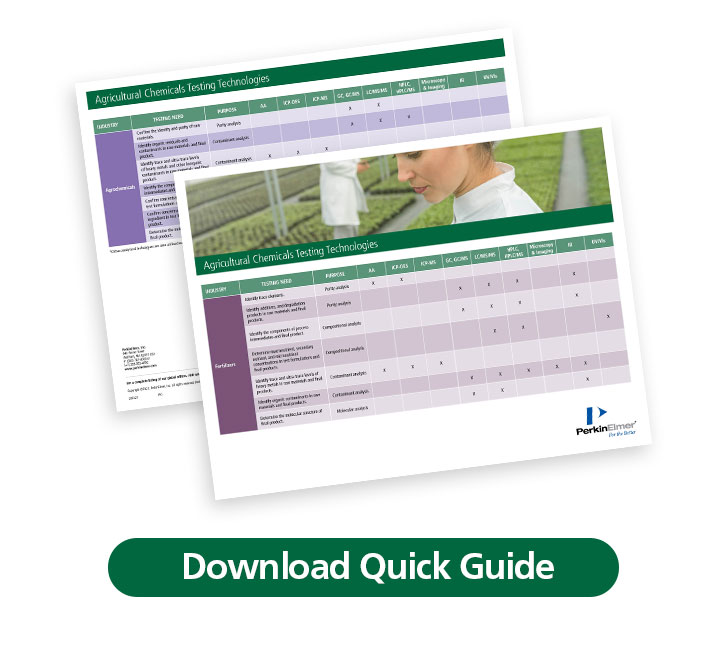Your Tour Guide to Fertilizer and Agrochemical Analytical Technologies
The fertilizer and agrochemical industries use comprehensive analytical programs on compounds that span from raw materials to final product during research and development (R&D) and production workflows.
Let’s take a quick tour of the types of technologies needed for fertilizer mining, agrochemicals R&D, blend manufacturing, and QA/QC-and what is needed along the way.
Spectroscopy
Spectroscopy, also called spectrometry, is used to identify the chemical makeup of a material. These techniques are useful for identifying organic and inorganic compounds and elemental components in a material. The most commonly used spectroscopic methods are:
- Fourier transform infrared spectroscopy (FTIR)
- X-ray photoelectron spectroscopy (XPS)
- Ultraviolet-visible-near infrared spectroscopy (UV-Vis-NIR)
- Nuclear magnetic resonance spectroscopy (NMR)
- Optical emission spectroscopy (OES)
- Raman spectroscopy
- Mass spectroscopy (MS)
Spectroscopy techniques measure the absorption/transmission of light and other types of radiation, or the energy emitted from the interactions of excited particles in the material. The absorption or collision-energy patterns of the material provide a chemical “fingerprint” of its components.
Chromatography
Chromatography techniques are used to separate and identify the components of material. These capabilities are important in identifying unknown materials, confirming a material’s makeup, and reverse engineering/deformulation of materials for R&D purposes. Important chromatography techniques include:
- Gas chromatography (GC)
- Liquid chromatography (LC)
- High-/ultra-high-performance liquid chromatography (HPLC, UHPLC)
- Size exclusion chromatography, gel permeation chromatography (SEC, GPC)
Chromatography hyphenated with spectroscopy adds the ability to quantify the separated components. GC, LC, and HPLC/UHPLC are often hyphenated with mass spectroscopy to provide these dual capabilities.
Hyphenation refers to the coupling of two or more instruments to increase the power of analysis. For example, GC/MS is gas chromatography coupled with mass spectrometry, a powerful combination that provides separation, identification, and trace-level quantification in a single workflow. Using hyphenated workflows such as these provides more information in less time.
Microscopy
Microscopy is used to characterize a material’s structural features that are not visible to the naked eye. Microscopy methods provide information about material size, shape, structure, surface topography, crystallinity, some types of degradation, and other structural characteristics.
Microscopic analysis typically begins with optical methods that magnify the sample image from 10 to 1,000 times. Transmission electron microscopy, scanning electron microscopy, and atomic force microscopy provide greater magnification when needed, reaching micro-, nano-, and even molecular-scale analyses. This type of information is used to evaluate a material’s conformity to specifications, investigate causes of undesirable material characteristics or product failure, and identify features that contribute to superior product performance.
These microscopy imaging techniques are often hyphenated with FTIR spectroscopy to provide high-resolution images of the material under investigation.
Structural Analysis
In addition to microscopy, a material’s structure can be investigated using X-ray diffraction analysis (XRD). This technology provides information on a material’s crystalline, microcrystalline, or amorphous structure, and examines crystal size, atomic arrangement, imperfections, and other structural material-specific parameters. As with microscopy, XRD is used to evaluate material compliance, problems or failure, and performance-enhancing features.
Elemental Analysis
Elemental analysis techniques are used to quantify elements and other inorganics, such as cations and anions, in solid and liquid materials. Elemental technologies include:
- Inductively coupled plasma (ICP); when hyphenated with optical emission spectroscopy (ICP-OES) it is used to identify and quantify trace levels of metals.
- ICP hyphenated with mass spectrometry (ICP-MS) is used to identify and quantify ultra-trace levels of metals.
- X-ray fluorescence is used to identify and quantify major and trace levels of elements
- Energy dispersive X-ray analysis (EDX) is used to identify and quantify the elemental composition of materials and determine the spatial distribution of elements in the material.
Data on trace levels of metals and inorganics in materials are useful in monitoring and improving product formulations and production processes, identifying contaminants and their sources, and maintaining regulatory compliance.
Download our Agricultural Chemical Testing Technologies quick reference guide now.


